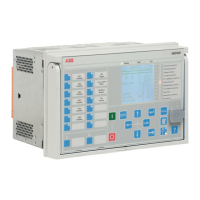been detected. The change in the magnitude of I
2
(ΔI2) on the other sets of the
current transformer (other than where zero current is detected) is calculated. If
the change is detected on the healthy sets of CT, it is an indication of system
failure.
• A zero current due to the CT failure does not result in a phase angle difference
between the healthy phases.
If a system faults happens on the phase A, it results in a change in the phase
angle difference between phase B and phase C. This change in the phase angle
difference between the healthy phases is evaluated in all three sets of current
transformer, and if the change is detected in any set of CT, it is an indication of
the system failure.
If both conditions are satisfied at zero current, the FAIL output is activated
immediately. The ALARM output is activated after a fixed 200 ms delay. FAIL
needs to be active during the delay. The outputs FAIL, CTGRP1, FAIL_CTGRP2 and
FAIL_CTGRP3 are activated according to the CT group where the secondary failure
is detected.
Activation of the BLOCK input deactivates the FAIL and ALARM outputs.
It is not possible to detect the CT secondary failure happening
simultaneously with the system faults or failures or two simultaneous
failures in the secondary circuit. The function resets if the zero current
does not exist longer than 200 ms.
Internal blocking
This module blocks the function internally under specific condition to avoid any
false operation during a system fault situation. When any of the following condition
is satisfied, the function is internally blocked and the FAIL output is deactivated
immediately.
• Magnitude of any phase current for any group of current transformers exceeds
the
Max operate current
setting. The magnitude of phase current is calculated
from the peak-to-peak value.
• Magnitude of the negative-sequence current I
2
on the healthy set of current
transformer exceeds the
Max Nq Seq current
setting.
The INT_BLKD output is activated when FAIL is deactivated if any of the
above conditions is satisfied. The ALARM output is also deactivated after a fixed
threesecond delay after the FAIL output is deactivated.
6.3.5 Application
Open or short-circuited current transformer secondary can cause unwanted
operation in many protection functions, such as earth-fault current and differential.
The simplest method for detecting the current transformer secondary failure is by
comparing currents from two independent three-phase sets of CTs or the CT cores
measuring the same primary currents. Another widely used method is the detection
of a zerosequence current and zero-sequence voltage. The detection of a zero-
sequence current in the absence of a zero-sequence voltage is an indication of the
current transformer secondary failure. However, both methods have disadvantages
as they require an additional set of current transformer, or a voltage channel is
needed for detecting a zero-sequence voltage.
1MRS757644 H
Supervision functions
620 series
Technical Manual
887

